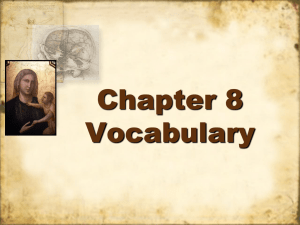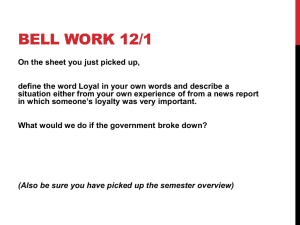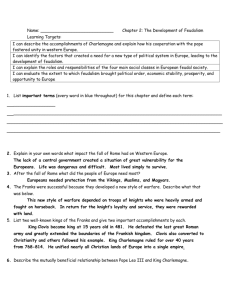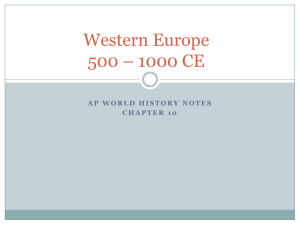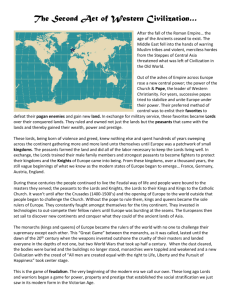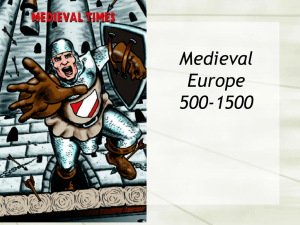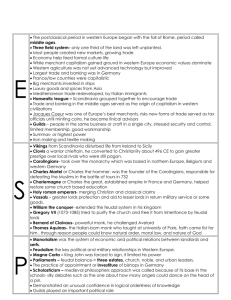Feudalism-Medieval Notes
advertisement
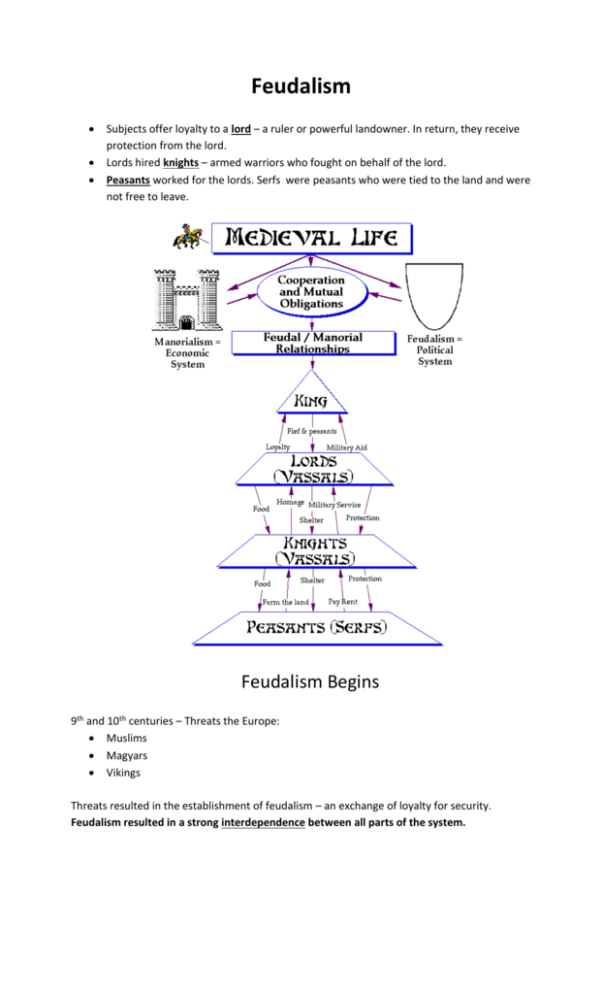
Feudalism Subjects offer loyalty to a lord – a ruler or powerful landowner. In return, they receive protection from the lord. Lords hired knights – armed warriors who fought on behalf of the lord. Peasants worked for the lords. Serfs were peasants who were tied to the land and were not free to leave. Feudalism Begins 9th and 10th centuries – Threats the Europe: Muslims Magyars Vikings Threats resulted in the establishment of feudalism – an exchange of loyalty for security. Feudalism resulted in a strong interdependence between all parts of the system. By 1000 CE, Europe had a well-established feudal system. King: Owned most of the land (churched owned a great deal as well) Gave fiefs (land grants) to lords (vassals) Lords promised loyalty and to provide a private army (knights) to protect the kingdom. Lords: Received land from the king (fiefs) Hired knights (vassals to the lords) to provide protection in time of war Made arrangements with lesser lords Peasants: Worked for the lords Bottom of the social system Rented land from the lords Serfs – tied to the land. They could not leave the land and had to farm in exchange for a small plot of land. Lords and wealthier knights lived on manors: Castle or manor house One or more villages Surrounding farmland Self-sufficient – most of what was needed on the manor was produced there. Medieval Social Class Most people were born into a social class, and remained there for life. They often had the same social position and job as their parents. Monarchs: Top of feudal society Expected to keep law and order, and provide protection for his/her vassals. Divine Right of Kings: Idea that God had given them the right to rule. Few had the wealth to maintain their own army. Had to rely on lords to provide enough knights. Usually lived in a castle for protection and as a reminder of hierarchy within the kingdom. Lords: Members of nobility Lived on manors (sometimes more than one) Manor house was the center of the community – Court, festivals, celebrations. Responsibility to defend and manage the land and the people who worked on it. Appointed officials to make sure villagers carried out their duties. Acted as judges Fiefs could be held by men and women Noblewomen – raising and training children, overseeing the household (sometimes hundreds of people) Knights: Mounted soldiers Usually wealthy (Armor was expensive!) Vassals of wealthy lords Loyal to the church and to the lord Path to Knight: o 1. Page – about seven years (lived in castle of a lord). Learned how to ride, religious instruction, sing, dance, manners. o 2. Squire – Trained under a knight. Polished armor and attended to needs of the knight. Trained in combat with lance, battle-ax, and mace. Code of Chivalry – Expected to be just and fair. However, they were expected to do the bidding of the lord, and sometimes acted outside the code. 11th century – Chain maille 14th century – Plate armor 17th century – Gunpowder/technology made knights obsolete Peasants: Most people were peasants Supported the feudal system by working the land and freeing lords to engage in other activities (war, leisure) Free or Unfree o Free – Rented the land and owed nothing more than rent to the lord. o Unfree – Serfs: farmed the lord’s land and were not allowed to leave the estate. In return for their labor, they were given a plot of land to farm for their own needs. Mostly worked the land or raised animals. Some were craftsmen (carpenters, shoemakers, smiths, etc). Must pay numerous taxes: o Head Money – fixed amount each year o Tallage – additional money in times of need o Merchet – marriage fee Required to mill their grain at the lord’s mill. Lord could keep whatever he/she wanted. Some peasants kept secret hand mills in their homes to avoid taking everything to the lord’s mill. Small homes – few possessions. Everyone lived in small space with animals. Ate mostly vegetables, meat, spices, salted/preserved meat, dense bread. Role of the Church Age of Faith The church was the center of medieval life. Almost every village had a church. Church bells called people to worship or warned of danger. The church was the center of community activity: plays, concerts, meetings, services, festivals, fairs. Provided education to some, and helped the poor and the sick. A part of everyday life People used the church to explain everyday events: Storms Disease Famine God would deliver them from disaster if they had faith. The Beginning of Christianity The Church was a powerful force in the Medieval world. In the year 400 C.E., the majority of people in Western Europe were polytheistic. 500 years later, the majority were Christian (monotheistic), and the Church was the dominate force in politics and economics. In 4 or 6 B.C.E., Jesus of Nazareth was born. (How do we know the year?) Most of what is known about life of Jesus has been gathered from the New Testament of the Bible. The first four books of the New Testament provide the most information. They are Matthew, Mark, Luke, and John. These books are often called the Gospels or good news. The Gospels give scholars little information about the early life of Jesus. All of the Gospels pick up the life of Jesus at about 30 years of age when his is baptized at the River Jordan by a preacher named John the Baptist. According to the Gospels, Jesus saw a vision of the Holy Spirit and as a result, began to preach. Jesus preached a simple message: People are children of God, and should help each other. People should love God, repent of their sins, and accept God’s forgiveness. People should forgive others and care for the poor. A central idea of his message was that a new age was at hand: The kingdom of heaven. Jesus’s message was popular with the public, but made him very unpopular with certain religious leaders. Many believed that his teachings disrupted the status quo in Rome. His criticism of the Temple and his message that God was more concerned about love than Jewish law angered many leaders. Christ was put to death by crucifixion (Roman punishment for enemies of the state) in the first century C.E. Christians believe that Christ was the son of God, Crucifixion - Andrea del Castagno, 1450 that God sent him to Earth to save people from their sins, and that he rose from the dead after his death. At first, Romans persecuted Christians for their beliefs. However, the religion continued to grow. Eventually, Emperor Constantine (Edict of Milan in 313 C.E.) declared that Christians could practice their religion. Emperor Theodosius adopted Christianity as the state religion of the Roman Empire (395 C.E.). Influence of the Catholic Church The church was an important influence for many people in the Middle Ages. After the fall of Rome, the church played a vital role in society. Many people looked to the church for something stable in unstable times. There was comfort in something that didn’t change and offered a reward after death for a pious (religious devotion to God) life. Monasteries: Community of Monks which served to help the poor and act as religious centers. Monks copied texts which helped to keep learning and information alive. Books were very rare. Most people were illiterate. Catholic Church: Pope Cardinals Archbishops (archdioceses) Bishops (dioceses) Priests (parish) The church became the wealthiest landowner in Europe by 1050 C.E. With great wealth came great power and influence. Some land was acquired by gifts from monarch or lords, and some was taken by force. Tithe: expectation that each person gave one tenth of earnings to the church. Money was used to buy land and add to the wealth of the church. The church and the Pope had great political influence. Education Trusted advisors Great influence over ordinary people Example: The fight between Pope Gregory VII and Henry IV Pope Gregory ruled that only the pope could appoint priests, bishops, and the head of monasteries. Gregory outlawed the selling of church offices. Henry IV believed it was his right to appoint who he wanted to these offices. Moves to have Pope Gregory removed as pope. Pope Gregory excommunicates Henry IV from the church. Declares that his subjects no longer have to obey the king. Henry IV begs forgiveness (stands in the snow for three days) and is allowed back in the church. Henry recognizes the power and influence of the church even over his own authority. Pilgrimage Because of their strong faith, many people of religious faith performed a pilgrimage to show extraordinary devotion. They performed the pilgrimage to show devotion to God, but also as a penance for their sins, or in hopes of being cured of an illness. Pilgrimage: A journey to a holy site. (Jerusalem or Rome, churches that housed relics) Relic: an object considered holy because it belonged to, or was touched by, a saint or other holy person. Travel was dangerous and was often on foot. It required true dedication. Robbers and thieves were common along the path that pilgrims traveled, so they often traveled in groups for safety. Special roads and bridges were constructed along the routes, and monks set up hostels (guest houses) so travelers would have somewhere to stay. Education Most schooling took place in monasteries, convents, or churches. Charlemagne began the idea of churches teaching people to read or write. Religious leader were the ones most likely educated. Education wasn’t for everyone. Most students were the sons of nobles studying for a position in the church. They memorized prayers and passages from the Bible. Books at the time were hand copied and were rare and expensive. Teachers mostly read to their students. The church was uncomfortable about the study of ancient texts of the Greeks and Romans. Greek and Roman philosophers taught about reason and logic. The church believed that reason and logic could be used to challenge the teachings of the church. Thomas Aquinas believed that there was no contradiction between faith and reason. Both were gifts from God, and reason could be used to uncover important truths about God. Holidays There were many holidays and festivals. Most of them centered around the church and religion in some way. Holiday comes from “holy day.” Greatest medieval holidays were Christmas and Easter. Eating, music, singing, dancing Christmas: (Birth of Christ) No trees, but evergreens and berries Lasted 12 days. On the last day would be a feast put on by the lord of the manor for everyone. Easter: (Death and resurrection of Christ) Large feast Games Eggs (celebration of new life) Towns and Villages After the fall of the Roman Empire, people lived in scattered communities all over Europe. By the High Middle Ages, towns were growing again. Farmer were expanding their fields and adopting better farming methods. Some towns grew wealthy because merchants within the towns were specializing in a specific type of product. For example, Flanders was known for its fine wool clothing, and Venice was known for its glass. Towns were originally part of a feudal lord’s domain, but as the towns grew, the people felt they no longer needed to pay the high taxes and they didn’t need the lord’s protection. Northern France and Italy: Towns established/purchased charters which allowed then to run their own affairs without a feudal lord telling them what to do. They became independent and could make their own laws and raise their own taxes. The mayor and town council were in charge. Merchants and towns people ran their community. Guilds Both trade and production of goods were overseen by organizations called Guilds. A guild is an organization of people in the same craft or trade. There were two main types of guilds: Merchant guilds Craft guilds All types of craftspeople had their own guilds, from cloth making to cobblers to stonemasons Guilds provided: Protection: controlled hours of work, set prices, dealt with complaints from customers, High standards: Punishment for cheaters or cutting corners. Guild members paid dues to their guild. Their dues paid for the construction of guildhalls and for fairs and festivals. Guild dues also provided for sick or injured members in time of need. It was difficult to get into a guild: Apprentice: o Starts at age 12. o Work under a master of the trade o Master provided home, food and training o Apprentices rarely got paid o After 7 years of training, they had to prove they had mastered the trade. Master piece If approved, apprentice could set up own shop/business o Rarely could they afford their own business Journeyman (daily work) Trade and Commerce During most of the Middle Ages, most products were luxury items bought by the wealthy. By the High Middle Ages, common goods were being bought and sold. Wool Glass Silk Food Household items Most towns had a market where goods were bought and sold. Large merchant fairs, held a couple of times a year, were huge gatherings of merchants. Goods for sale could come from all over Europe. Merchants grew increasingly powerful and wealthy. They became important political figures, and had a lot of say in local politics and government. Homes and Households Medieval town were small and crowded. Most homes were made of wood, narrow, and could be up to 4 stories high. As homes aged, they would lean. Homes could lean so far that they could touch a home on the other side of the street! In poorer neighborhoods, several families might share a home. It might have one room where everyone slept and ate. Most worked out of their homes because owning a shop was an added expense they could not afford. Wealthy families might have two or three stories, where they separated the work spaces from the dining and sleeping spaces. They may even have spaces for servants or apprentices. Most homes, whether wealthy or not, were cold, smoky and dim. Fireplaces were the only source of heat as well as the main source of light. Windows were small and covered with oil parchment instead of glass, so little sunlight came through. Growing up in a medieval town wasn’t easy. Half of all children died before they became adults. Children began preparing for adulthood at the age of seven. In general, people of the Middle Ages believed in an orderly society in which everyone knew their place. Most did the same work as their parents, and most girls married very young (12 years). For most girls, education was at home. They learned the skills necessary to run the home. Disease and Medical Treatment Medieval town were very unhealthy. They were very dirty, with no running water, outdoor toilets or chamber pots, and no sanitation. Garbage was tossed into the street or into canals or streams. People usually bathed only once a week, if that. Rats and fleas were common, and often carried disease. No wonder only half the children lived to be adults. Common diseases: Cholera Measles Scarlet fever Bubonic plague When diseases erupted, the people usually found someone to blame. Jews were often accused of poisoning the wells. Hospitals were rare. Most people were treated in homes by family members, or sometimes, a doctor. Medieval doctors believed in a combination of prayer and medical treatment. Many treatments involved herbs. Sometimes a belief in the alignment of the planets or magic charms were used to treat the sick. Another common practice was bleeding the patient by applying leeches or opening a vein. Bloodletting helped restore balance to the body and the spirt many doctors believed.
